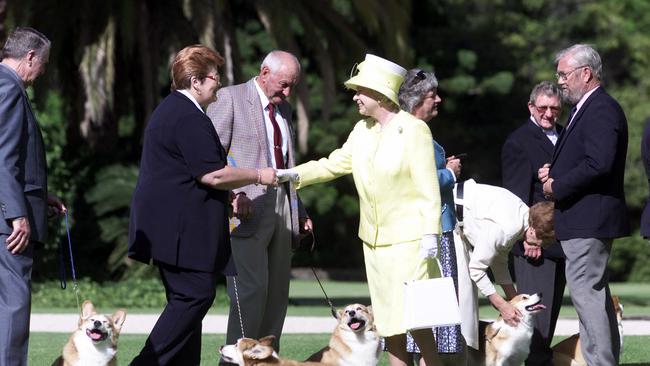She has been the composed, regal back drop for most of us forever
From corgis breeders, to Governors-General, to garden parties, the Queen took it all in her stride – and often all in the same day.

There has never been anyone like her. Over more than 25,000 days as the longest serving monarch in Britain – and Australia – she etched her way into history. She also inserted herself into our lives, often subliminally, and overwhelmingly remotely, but in a way that still made us feel we knew her.
For anyone younger than 70, she was our only monarch: the bearer of that unmistakeable profile on coins and old stamps, namesake of busy thoroughfares in our biggest cities, the woman to whom our national anthem, until a few decades ago, was dedicated.
Her ubiquity rendered her familiar. Who, over a certain age, didn’t recognise the ever-present handbags she carried in the crook of her arm? The gloved hands? The cadence of her delivery during her annual Christmas message? She was the regal backdrop to so many lives, the composed face who filled our TV screens even though she was never likely to set foot in our lounge rooms.
For those who did meet her – she hosted well over a million people at garden parties, alone -– there was a sense of comfortable familiarity, even if it was often also mixed with awe. Talking to her, even briefly, was like meeting a distant relative for the first time: unexpected but also keenly recognisable.
When she toured Australia in 2002 during her golden jubilee as monarch, her ease with public life was obvious. At a cocktail party for media covering the tour, where she was introduced to dozens of people after a busy day involving countless more introductions, she was amiable and relaxed, chatting about how she had enjoyed soaring above the Barron Gorge National Park in far north Queensland on its rainforest cableway.
For those less accustomed to clamouring crowds, meeting and greeting countless people every day might have seemed inane, infuriating even, let alone the endless calendar of events, some of them tedious. But she thrummed with good humour and good will, despite a typically packed itinerary. On just one day of that five-day tour she met dog owners in Adelaide, took a train to the Barossa, attended a welcome ceremony in Gawler, planted a bush and opened a rose garden, had a sit down lunch, opened a high-care facility, and, then, when most people started to tuck in to dinner, she flew to Brisbane.
And all the while Australia was being gripped by a constitutional scandal. The governor-general Peter Hollingworth stood accused of having failed to appropriately deal with sexual abuse allegations against a church teacher during his time as Anglican archbishop of Brisbane. Not only was the Queen the head of that church, but Hollingworth was now her representative in Australia. One of the tour’s final stops would be at St John’s Cathedral in Brisbane, where Hollingworth had worked when he had allegedly mishandled the abuse claims. There, the Queen would be hosted by his successor, Phillip Aspinall – who had ordered an inquiry into the way the diocese had handled sexual abuse allegations during the former archbishop’s tenure.
If this was a family wedding, it might have been cancelled. Instead, on one memorable day of that trip, the central players in the constitutional drama gripping Australian political life came face to face in a most respectful way: the embattled governor-general, prime minister John Howard, who was refusing to sack him, and the only person who could officially change Howard’s mind – the Queen.
With her carefully honed mix of charm and manners, she oversaw a very civilised welcome. There were smiles and bows, and still more geniality when, after a 21-gun salute, she was also introduced to the federal opposition leader Simon Crean, who had called for the governor-general to be dismissed.
Watching on, it made you wonder what it must have been like to live this life, with its privilege and problems and its many rules: hats at formal events, tiaras after 6pm, no one to turn their back on you or to leave before you and no one, outside of your family, to touch you. If you’ve ever felt uncomfortable being sung Happy Birthday, what would it be like to have a national anthem belted out in your honour, a parade on your birthday, toasts all around, a room falling silent while others sing to God to save you?
How hard would it be to grab a few moments of normality, when everywhere, it seemed, there were reminders of you and your notable relatives? On that busy day in Adelaide almost 20 years ago, she arose from her bed, just off King William Street, met with the owners of champion corgies who had all won the coveted Queen’s trophy, travelled through the suburb of Elizabeth, past the Philip Highway and Prince Charles Street, and on to Gawler where a young girl confided that she had named a couple of her chooks Queenie and Lizzy.
Like everything on that trip, the Queen took the news in her stride, politely, genially, and memorably. And like that, it seemed, it was over, and she was gone.




To join the conversation, please log in. Don't have an account? Register
Join the conversation, you are commenting as Logout